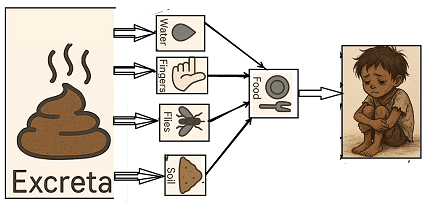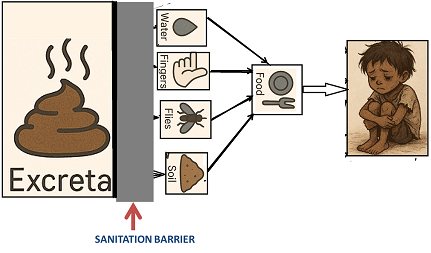How Diseases Spread from Human Excreta & What is a Sanitation Barrier? Simple Public Health Guide
How do Diseases Spread from Human Excreta?
Diseases can spread from human waste if not properly managed. When a sick person or a disease carrier passes excreta, it contains germs that can travel in different ways, including:
1. Water – Contaminated drinking water can spread diseases like cholera and typhoid.
2. Fingers – Poor hand hygiene can transfer germs to food and surfaces.
3. Flies – Flies pick up germs from waste and land on food.
4. Soil – Open defecation can pollute the ground, leading to infections.
5. Food – Unclean hands, flies, and contaminated water can make food unsafe to eat.
What is a Sanitation Barrier?
A sanitation barrier is a system that stops human waste from spreading disease.
Think of it as a shield that blocks germs from reaching people.
Community health programs focus on breaking this chain of disease at key points, including:
1. Safe disposal of waste – Using sanitary latrines and proper waste management.
2. Clean water protection – Keeping drinking water sources free from contamination.
3. Food safety – Storing and preparing food in a clean environment.
4. Personal hygiene – Washing hands with soap and maintaining cleanliness.
5. Fly control – Preventing flies from breeding near waste.
The most effective way to block these diseases is to separate human waste and dispose it safely. This is known as the ‘Sanitation Barrier’.
• This would ensure that the source of infection is isolated at the outset, preventing it from reaching other transmission routes such as flies, water sources, food, or hands."
• In other words, a ‘Sanitation Barrier’ is created between human excreta and the various disease transmission channels
• Sanitation Barrier breaks this disgusting cycle of fecal borne disease transmission
The easiest way to build a sanitation-barrier: A sanitary toilet!
• This can vary from a simple ‘Pit latrine’ where the excreta are safely handled locally to complex sewer pipes and sewage treatment plants.
Simply put: no open defecation, no disease transmission, fewer sick people
As a healthcare person: you’ll see patients suffering from preventable poop-borne diseases.
As a citizen: you can promote toilets, hygiene, and clean water in your community.
References:
• Park's Textbook of Preventive and Social Medicine. 26th ed. Jabalpur: M/S Banarsidas Bhanot; 2021. Environment and Health; p. 799-883.
• Park's Textbook of Preventive and Social Medicine. 27th ed. Jabalpur: M/S Banarsidas Bhanot; 2023. Environment and Health; p. 832-915.
• Bhalwar R. Textbook of Community Medicine. 5th ed. New Delhi: Wolters Kluwer; 2023. Chapter 8, Excreta Disposal; p. 89-101.
Sanitation Barrier: https://ihatepsm.com/blog/sanitation-barrier-keeping-our-communities-hea...
Excreta Disposal: https://ihatepsm.com/blog/proper-excreta-disposal-necessity-health-and-d...
Video on Sewage Treatment: https://youtu.be/M3iMq4-iFHg
Bore-Hole Latrine: https://ihatepsm.com/blog/bore-hole-latrine#google_vignette
The Dug Well Latrine (Pit Latrine): https://ihatepsm.com/blog/dug-well-latrine-pit-latrine-more-practical-al...
Borehole vs. Dug-Well Latrines: A Comparison: https://ihatepsm.com/blog/borehole-vs-dug-well-latrines-comparison
Water-seal Latrine: https://ihatepsm.com/blog/water-seal-latrine
RCA Latrine: https://ihatepsm.com/blog/rca-latrine
Septic Tank: How it Works: https://ihatepsm.com/blog/septic-tanks-how-do-these-work
Aqua Privy: https://ihatepsm.com/blog/aqua-privy-how-does-it-work
